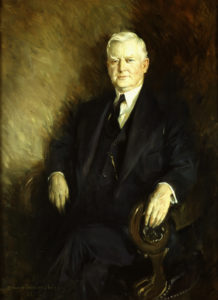For some years following his death in 1967, John Nance Garner of Uvalde had been all but lost to history. People don’t tend to remember or write about vice presidents. To complicate things, Garner and his wife, Ettie, destroyed much of his official correspondence and records after leaving the vice presidency in 1941.
Perhaps the most famous thing about Garner was his quote that the vice presidency wasn’t worth a bucket of warm spit. (Some have suggested that Garner in fact used a different four-letter word.)
But Garner played an important, if behind-the-scenes role, during his political career. Thanks in part to a 2015 documentary, “Cactus Jack,” Garner is starting to come back into view. (The video was produced by the Briscoe Center for American History at the University of Texas at Austin, and has been broadcast on public television.)
Garner was born and raised in Northeast Texas. He became a trial lawyer and resettled in Uvalde, in South Texas. A Democrat, he ran for Uvalde County Judge in 1893. He drew an opponent who couldn’t vote for herself—Mariette “Ettie” Rheiner—because this was in the era before women had the right to vote.
Garner and Ettie married in 1895. She would serve as his private secretary and closest adviser, a role not uncommon for political spouses of that era.
He went on to serve in the Texas Legislature. In Austin, Garner supported efforts to make the prickly pear cactus the state flower. His efforts failed—the bluebonnet became the state flower—but Garner got his nickname, “Cactus Jack,” from his efforts.
Garner was elected to the U.S. House of Representatives in 1902. Seniority played a big role in one’s advancement in Congress, and Garner worked to develop the friendships to move him up the ladder. He was elected Speaker of the House in 1931, the first Texan to hold that role.
His ascension to the speakership came during the Great Depression. Because of his prominence, Garner was among the names considered as a presidential possibility. The Democratic Party settled on New York Governor Franklin Delano Roosevelt when he agreed to put Garner on the ticket as the vice presidential candidate. They went on to win the 1932 election.
Garner’s friendships on Capitol Hill helped pave the way for Roosevelt’s New Deal programs, and the Roosevelt-Garner ticket won reelection in 1936. But the two men started having differences on various issues, including Roosevelt’s plan to reorganize the Supreme Court.
Roosevelt decided to break the two-term tradition and seek a third term in 1940. Garner sought the office himself. Roosevelt was renominated and reelected. Garner retired to Uvalde.
The big political figures of his era often visited Garner in retirement. One such visit came during the 1948 presidential campaign, where he welcomed President Harry S. Truman, Speaker Sam Rayburn, and then-Congressman Lyndon B. Johnson, who would be elected to the Senate. On his 95th birthday, November 22, 1963, Garner received a congratulatory call from President John F. Kennedy, who would be assassinated later that day.
Garner was also a mentor to his fellow townsman Dolph Briscoe Jr., who would serve as governor from 1973-79. Briscoe cited Garner’s political credo in his first inaugural address: “There are just two things to this government as I see it. The first is to safeguard the lives and properties of our people. The second is to ensure that each of us has a chance to work out his destiny according to his talents.”
Garner’s home in Uvalde, now known as the Briscoe-Garner Museum, houses exhibits of Garner’s life and career. The popular state park in nearby Concan was also named in Garner’s honor.
Texas is known for its share of colorful political figures. Cactus Jack Garner surely belongs on that list.

